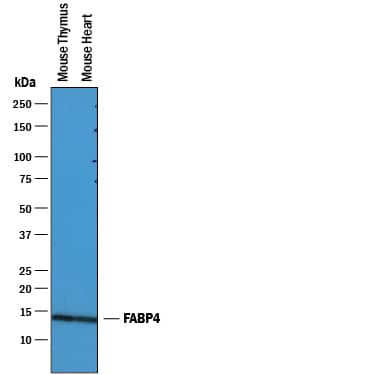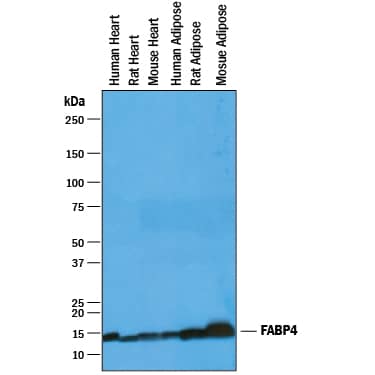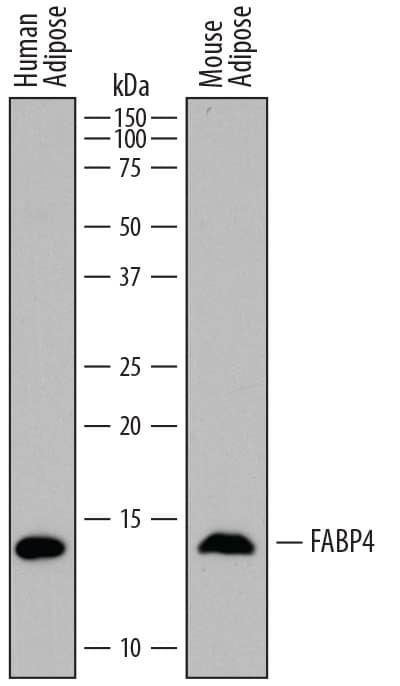FABP4/A-FABP Products
Fatty Acid Binding Protein 4 (FABP4), also known as A-FABP and aP2, is the predominant FABP found in adipocytes and is often used as a marker for adipocyte differentiation. It is also expressed in macrophages, dendritic cells, and endothelial cells. FABP4 is a key mediator of intracellular fatty acid transport and metabolism in adipose tissue. I...
52 results for "FABP4/A-FABP" in Products
52 results for "FABP4/A-FABP" in Products
FABP4/A-FABP Products
Fatty Acid Binding Protein 4 (FABP4), also known as A-FABP and aP2, is the predominant FABP found in adipocytes and is often used as a marker for adipocyte differentiation. It is also expressed in macrophages, dendritic cells, and endothelial cells. FABP4 is a key mediator of intracellular fatty acid transport and metabolism in adipose tissue. I...
| Reactivity: | Mouse, Rat |
| Details: | Goat IgG Polyclonal |
| Applications: | WB, Simple Western, IHC, ICC |
| Reactivity: | Human |
| Details: | Goat IgG Polyclonal |
| Applications: | WB, Simple Western, ELISA, IHC |
Recombinant Monoclonal Antibody
| Reactivity: | Human |
| Details: | Mouse IgG1 kappa Monoclonal Clone #rFABP4/8536 |
| Applications: | IHC |
| Sensitivity: | 14.2 pg/mL |
| Applications: | ELISA |
| Assay Range: | 62.5 - 4,000 pg/mL (Cell Culture Supernates, Cell Lysates, Serum, EDTA Plasma, Heparin Plasma) |
| Reactivity: | Human |
| Details: | Mouse IgG1 kappa Monoclonal Clone #FABP4/4422 |
| Applications: | IHC, MA |
| Reactivity: | Human |
| Details: | Mouse IgG1 kappa Monoclonal Clone #FABP4/4422 |
| Applications: | IHC, MA |
Recombinant Monoclonal Antibody
| Reactivity: | Human |
| Details: | Rabbit IgG Kappa Monoclonal Clone #FABP4/8537R |
| Applications: | IHC |
Recombinant Monoclonal Antibody
| Reactivity: | Human |
| Details: | Mouse IgG1 kappa Monoclonal Clone #rFABP4/8536 |
| Applications: | IHC |
Recombinant Monoclonal Antibody
| Reactivity: | Human |
| Details: | Mouse IgG1 kappa Monoclonal Clone #rFABP4/8536 |
| Applications: | IHC |
Recombinant Monoclonal Antibody
| Reactivity: | Human |
| Details: | Rabbit IgG Kappa Monoclonal Clone #FABP4/8537R |
| Applications: | IHC |
| Reactivity: | Human, Mouse, Rat |
| Details: | Rabbit IgG Polyclonal |
| Applications: | IHC, WB, Simple Western |
Recombinant Monoclonal Antibody.
| Reactivity: | Human, Mouse, Rat |
| Details: | Rabbit IgG Monoclonal Clone #JM10-99 |
| Applications: | IHC, WB, ICC/IF |
| Reactivity: | Human, Mouse |
| Details: | Rat IgG1 Monoclonal Clone #804914 |
| Applications: | WB, ELISA |
| Reactivity: | Mouse |
| Details: | Goat IgG Polyclonal |
| Applications: | WB, IHC |
| Assay Range: | 62.5 - 4,000 pg/mL |
| Applications: | ELISA |
| Reactivity: | Human, Mouse |
| Details: | Rabbit IgG Polyclonal |
| Applications: | IHC, WB, ELISA, ICC/IF |
| Source: | E. coli |
| Accession #: | P04117 |
For use with catalog number DFBP40
| Applications: | ELISA, Ctrl |
| Applications: | ELISA |
| Applications: | ELISA |
| Applications: | AC |
Recombinant Monoclonal Antibody
| Reactivity: | Human |
| Details: | Rabbit IgG Monoclonal Clone #001 |
| Applications: | IHC, Flow |
Recombinant monoclonal antibody expressed in HEK293F cells
| Reactivity: | Human |
| Details: | Rabbit IgG Monoclonal Clone #1H4 |
| Applications: | ELISA |
Recombinant Monoclonal Antibody
| Reactivity: | Human |
| Details: | Rabbit IgG Monoclonal Clone #001 |
| Applications: | IHC, Flow |
Recombinant Monoclonal Antibody
| Reactivity: | Human |
| Details: | Rabbit IgG Monoclonal Clone #001 |
| Applications: | IHC, Flow |






![Immunohistochemistry-Paraffin: FABP4/A-FABP Antibody [NBP1-89218] Immunohistochemistry-Paraffin: FABP4/A-FABP Antibody [NBP1-89218]](https://resources.bio-techne.com/images/products/FABP4-A-FABP-Antibody-Immunohistochemistry-Paraffin-NBP1-89218-img0016.jpg)
![Western Blot: FABP4/A-FABP Antibody (JM10-99) [NBP2-66828] Western Blot: FABP4/A-FABP Antibody (JM10-99) [NBP2-66828]](https://resources.bio-techne.com/images/products/FABP4-A-FABP-Antibody-JM10-99-Western-Blot-NBP2-66828-img0005.jpg)


![Immunocytochemistry/ Immunofluorescence: FABP4/A-FABP Antibody [NBP1-33616] Immunocytochemistry/ Immunofluorescence: FABP4/A-FABP Antibody [NBP1-33616]](https://resources.bio-techne.com/images/products/FABP4-A-FABP-Antibody-Immunocytochemistry-Immunofluorescence-NBP1-33616-img0006.jpg)

![ELISA: Mouse FABP4/A-FABP ELISA Kit (Colorimetric) [NBP2-82410] - Mouse FABP4/A-FABP ELISA Kit (Colorimetric)](https://resources.bio-techne.com/images/products/nbp2-82410_mouse-fabp4-a-fabp-elisa-kit-colorimetric-132202416243435.jpg)
![ELISA: Rat FABP4/A-FABP ELISA Kit (Colorimetric) [NBP2-82484] - Rat FABP4/A-FABP ELISA Kit (Colorimetric)](https://resources.bio-techne.com/images/products/nbp2-82484_rat-fabp4-a-fabp-elisa-kit-colorimetric-132202416175654.jpg)